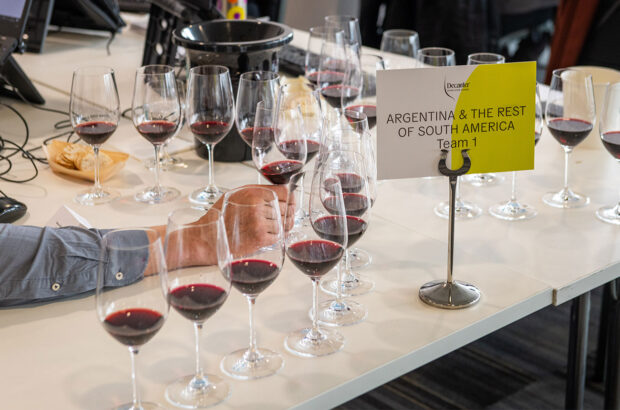There’s nothing better than enjoying a great meal surrounded by old friends – like DRC and the first growths. Fiona Sims charts the growing trend of cellar dining, here and abroad
Things have improved since the days when restaurants would present grubby wine lists littered with spelling mistakes and wrong vintages. Thankfully, for the most part, wine is no longer an afterthought. Moreover, a number of new openings not only use wine as an integral part of the restaurant’s offer but have set out to create a dining experience in the wine cellar itself.
The latest is London hotel The Connaught. Underneath a new wing, the redesigned cellar boasts design by Provence craftsmen, and a menu from the hotel’s incumbent Michelin-starred chef Hélène Darroze. The cellar’s curator is head sommelier Mathieu Gaignon, who oversees the 8,000 bottles on his 1,000-bin list, dominated by red Bordeaux and white Burgundy.
The cellar dining room, decorated with artefacts drawn from The Connaught over the years since it opened in 1897, is surrounded by wine – and you can see the Provençal gravel-floored cellar through a glass wall on one side of the oak-panelled room. The room seats up to eight and the menu is created and served by Darroze, featuring dishes that are a bit simpler than the restaurant.
Cliveden in Taplow, Berkshire, a stately home-turned-hotel, once belonged to the Astors and became the hub of high society in the early 1900s and again in the Sixties (think Profumo). It has many stories to share, quite possibly involving the cellar, which now has its own dining room, situated next to the hotel’s acclaimed Waldo’s Restaurant. If you ask nicely, you can get chef Chris Horridge’s modern British menu here, though it is the hotel’s second restaurant, The Terrace, that usually supplies the food.
But you do get to pick anything from Waldo’s 400-bin list. Put together by Alsace-born sommelier David Helbringer, this is almost equally split between the Old and New World, and ranges from a 2008 Alamos Torrontés from Argentina at £30 to Domaine de la Romanée-Conti Vosne Romanée 1993 at £3,495.
Part of the success of London’s Pont de la Tour can be attributed to its 900-bin wine list, enjoyed in the restaurant, on its Thames-side terrace, or in its Wine Cellar private dining room. Actually, there are two cellar dining rooms here – one next to the wine shop, where diners are invited to peruse the bottles for sale, and the second in a walled-off bit of the cellar itself, seating up to 20.
The wine shelves run the length of the room – albeit behind glass. ‘They can watch a proper working cellar while they eat,’ says head sommelier Nicolas Clerc. ‘They can even touch the bottles – we encourage it,’ adding that the best wines are stashed in a less accessible corner of the cellar. His special-occasion favourites to serve with chef Lee Bennett’s modern French food include a 1999 Clos Cazals Champagne at £250 and, for those really pushing the boat out, 1966 La Mission Haut-Brion at £965.
You don’t have to have a fat wallet to dine in a wine cellar, however. Vinoteca, on London’s St John Street, offers modest wines at modest prices, in ‘bistro chic’ surroundings. Co-owner Charlie Young had already seen the cellar-dining trend developing in Australia before he opened Vinoteca with Brett Woonton in 2005.
Their cellar dining room seats 30, though with a minimum spend of just £500, six happy folks can pair the £30 three-course menu with two or three of the bistro’s pricier bottles, such as a 1978 Borgogno Barolo at £165, or a 1986 Château Talbot at £150. The other end of the scale, meanwhile, allows for copious bottles of a declassified Rioja, Albizu’s RT 28 at £15.50.
Francesco Mazzei’s Italian restaurant, L’Anima, near London’s Liverpool Street, has taken the wine-as-interior-detail concept and run with it. Walk through the glass entrance and you see through to its handsome red wine cellar, with luxurious marble floor and walls. Visit the loo and you get closer still, while those booked into the private dining room are virtually right on top of it.
Any guest can visit sommelier Francesco Gaeta’s well-stocked cellar if they show an interest, but those in the 15-seat private dining room get to spend as much time in here as they want. It contains 300 bins from the mostly Italian 400-bin list, focusing on small producers using local grapes, from Elvio Cogno’s Rosso Piceno at £28 to ‘Supertuscans’ galore.
Two other new, high-profile London restaurants also use wine as a focus in their interiors. Galvin La Chapelle has bespoke dark wood arched fridges that hold more than 100 bottles, including its signature Jaboulet Aîné’s Hermitage La Chapelle (a rare 1961 is £19,500 a bottle). ‘It started out as a space issue, but then we decided to make a feature of the wine,’ says Sara Galvin.
Il Baretto, meanwhile, keeps some of its top bottles behind a temperature-controlled glass wall next to its largest table off the main dining area, highlighting its wine list and encouraging diners to be more adventurous – which is, ultimately, what wine is all about.
Written by Fiona Sims






